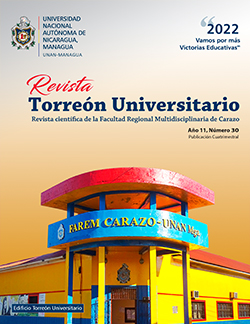Propuesta de valoración física de construcciones en avalúos inmobiliarios, implicación del factor proyecto en México
DOI:
https://doi.org/10.5377/rtu.v11i30.13428Palabras clave:
avalúo inmobiliario, factor proyecto, valoración físicaResumen
El factor proyecto, complementó el valor otorgado a una vivienda analizada en avalúos inmobiliarios. En este trabajo se presentó el diseño de metodología de análisis funcional de las habitaciones que integran cada vivienda, en combinación con el enfoque de depreciación física de Ross -Heidecke. Se realizó la medición de planos arquitectónicos de muestras de viviendas en México de todas las categorías socioeconómicas y se establecieron tres tipos de matrices para su valoración y parámetros porcentuales. Se analizó el tipo principal de construcción bajo el esquema de análisis por partidas de edificación y el resto de los tipos se examinó de manera unitaria. Los resultados porcentuales del análisis del muestreo, fueron direccionados a matrices del enfoque físico y en conjunto; con el factor de calificación del estado de conservación de cada partida de edificación, con el cálculo de un factor proyecto apropiado a cada clase de vivienda. El análisis automatizado, que calificó el valor de las construcciones con base en la funcionalidad de cada proyecto arquitectónico, complementó el estudio de la depreciación física. Los porcentajes resultantes de la muestra, calcularon cuanto mide cada habitación en la lógica de una simulación, que de acuerdo a la superficie total de edificación y al número específico de habitaciones, calificó la funcionalidad a superficies unitarias. Se hizo énfasis de que, el análisis de funcionalidad incluye la calificación de instalaciones e infraestructura. El resultado del factor de funcionalidad del proyecto arquitectónico, estuvo sujeto a los parámetros y requerimientos de códigos de edificación de viviendas en México.
Descargas
864
HTML 497
VISOR 0
PDF (English) 139
HTML (English) 366
Citas
Artavia Jiménez, D. A. (2012). Los modelos de depreciación aplicados en la valuación de bienes inmuebles.
Diario Oficial de la Federación, Sociedad Hipotecaria Federal. (24 de Febrero de 2012). Criterios generales para la realización y certificación de avalúos. México, Distrito Federal, México. Recuperado el 2018, de http://dof.gob.mx/nota_detalle.php?codigo=5235316&fecha=24/02/2012
Gobierno Federal Mexicano. (2010). Código de Edificacion de Vivienda CONAVI. México.
Gobierno Federal Mexicano. (2017). Código de Edificación de Vivienda CONAVI. México.
López, M. (2011). Tesis para obtener el grado de Maestro en Valuación inmobiliaria e industrial, “Metodología para estimar la edad física justa de casas habitación remodeladas”. Porcentajes representativos de partidas y clasificaciones de tipos de construcción .
Varela, A. (2000). Ingeniería de costos de construcción. México, D.F.
Varela, A. (2019). Ingeniería de Costos. Obtenido de https://www.varela.com.mx/
Villa Zamora, H. M. (2006). Tesis que para obtener el título de Maestro en Valuación Inmobiliaria e Industrial "Análisis del costo paramétrico y calculo del factor homologación por superficie de construcción para inmuebles de uso habitacional unifamiliar. Obtenido de https://infonavit.janium.net/janium/TESIS/Maestria/Villa_Zamora_Honorato_Martin_45445.pdf
Descargas
Publicado
Cómo citar
Número
Sección
Licencia
Derechos de autor 2022 Universidad Nacional Autónoma de Nicaragua, Managua (UNAN-Managua)

Esta obra está bajo una licencia internacional Creative Commons Atribución-NoComercial-SinDerivadas 4.0.
Los autores que publican en esta revista están de acuerdo con los siguientes términos.
- El autor o los autores de los artículos, ensayos o investigaciones conceden a la Universidad Nacional Autónoma de Nicaragua, Managua (UNAN-Managua) los derechos de edición (copyright) del trabajo enviado, por consiguiente la Universidad cuenta con el derecho exclusivo para publicar el artículo durante el periodo completo de los derechos de autor.
- Estos derechos de autor/ autores autorizan a la Revista Torreón Universitario y a la Universidad editar y divulgar/publicar el artículo en dicha Revista, incluyendo reproducción impresa y electrónica, el almacenamiento, recuperación y cualquier otro tipo de publicación, y fuentes de información secundaria como servicios de resúmenes y bases de datos, así mismo la facultan a proteger el artículo contra el uso no autorizado para su difusión por medios impresos o electrónicos (PDF, HTML, EPUB, XML u otros).
Licencia para el uso del contenido
La revista hace uso de la Licencia Creative Commons Atribución-NoComercial-SinDerivar 4.0 Internacional.
Bajo esta declaración:

Este revista está sujeta a una licencia de Creative Commons Reconocimiento-NoComercial-SinObraDerivada 4.0 Internacional. Puede ser copiada, distribuida y transmitida públicamente siempre y cuando se cite al autor y la fuente (Revista Torreón Universitario), no debe modificarse ni utilizarse con ningún fin comercial. La licencia completa se puede consultar en http://creativecommons.org/licenses/by-nc-nd/4.0/.



